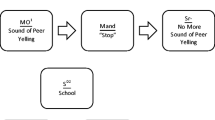Abstract
The functional independence of mand and tact operants (Skinner, 1957) has been demonstrated with humans and non-humans. The purpose of this study was to test whether functional independence held true for impure tacts and impure mands. Four educationally disabled preschoolers were taught to mand an item necessary to engage in a preferred activity, specifying the abstract stimulus property (e.g., “I want a whole crayon please”). Tact training of abstract stimulus properties consisted of teaching the students to tact an item, specifying the abstract stimulus property, before continuing with an unrelated activity (e.g., “That is a whole crayon”). Results indicated that students who were taught to mand an abstract stimulus property (“I want a whole crayon please”) did not tact the property (“That is a whole crayon”), and vice versa. In 9 out of the 10 conditions, impure mands or tacts for abstract stimulus properties did not reliably occur in the other function without direct training. In addition, training in the first function did not seem to expedite training in the second function. These results provide further support for Skinner’s (1957) assertion that the verbal operants are functionally independent at the time of acquisition, and have implications for teaching language to children who fail to acquire a typical verbal repertoire.
Similar content being viewed by others
References
Carroll, R. J., & Hesse, B. E. (1987). The effects of alternating mand and tact training on the acquisition of tacts. The Analysis of Verbal Behavior, 5, 55–65.
Catania, C. (1992). Learning. Englewood Cliffs, NJ: Prentice-Hall.
Chase, P. M., Johnson, K. R., & Sulzer-Azaroff, B. (1985). Verbal relations within instruction: Are there subclasses of intraverbal? Journal of the Experimental Analysis of Behavior, 43, 301–313.
Guess, D. (1969). A functional analysis of receptive language and productive speech: Acquisition of the plural morpheme. Journal of Applied Behavior Analysis, 2, 55–64.
Guess, D., Sailor, W., Rutherford, G., & Baer, D. M. (1968). An experimental analysis of linguistic development: The productive use of the plural morpheme. Journal of Applied Behavior Analysis, 1, 297–306.
Hall, G., & Sundberg, M. L. (1987). Teaching mands by manipulating conditioned establishing operations. The Analysis of Verbal Behavior, 5, 41–53.
Howard, J. S., & Rice, D. E. (1988). Establishing a generalized autoclitic repertoire in preschool children. The Analysis of Verbal Behavior, 6, 45–59.
Lamarre, J., & Holland, J. G. (1985). The functional independence of mands and tacts. Journal of the Experimental Analysis of Behavior, 43, 5–19.
Lee, V. L. (1981). Prepositional phrases spoken and heard. Journal of the Experimental Analysis of Behavior, 35, 227–242.
Lee, V. L., & Pegler, A. M. (1982). Effects on spelling of training children to read. Journal of the Experimental Analysis of Behavior, 37, 311–322.
Michael, J. L. (1988). The establishing operation and the mand. The Analysis of Verbal Behavior, 6, 3–9.
Michael, J. L. (1993). Establishing operations. The Behavior Analyst, 16, 191–206.
Partington, J. W., & Bailey, J. S. (1993). Teaching intraverbal behavior to preschool children. The Analysis of Verbal Behavior, 11, 9–18.
Savage-Rumbaugh, E. S. (1984). Verbal behavior at a procedural level in the chimpanzee. Journal of the Experimental Analysis of Behavior, 41, 223–250.
Savage-Rumbaugh, E. S., Rumbaugh, D. M., Smith, S. T., & Lawson, J. (1980). Reference: The linguistic essential. Science, 210, 922–925.
Sigafoos, J., Doss, S., & Reichle, J. (1989). Developing mand and tact repertoires in persons with severe developmental disabilities using graphic symbols. Research in Developmental Disabilities, 10, 183–200.
Skinner, B. F. (1957). Verbal behavior. Englewood Cliffs, NJ: Prentice-Hall.
Skinner, B. F. (1986). The evolution of verbal behavior. Journal of the Experimental Analysis of Behavior, 45, 115–122.
Stafford, M. W., Sundberg, M. L., & Braam, S. J. (1988). A preliminary investigation of the consequences that define the mand and the tact. The Analysis of Verbal Behavior, 6, 61–71.
Sundberg, M. L. (1985). Teaching verbal behavior to pigeons. The Analysis of Verbal Behavior, 3, 11–17.
Watkins, C. L., Pack-Teixteira, L., & Howard, J. S. (1989). Teaching intraverbal behavior to severely retarded children. The Analysis of Verbal Behavior, 7, 69–81.
Wheeler, A. J., & Sulzer, B. (1970). Operant training and generalization of a verbal response form in a speech-deficient child. Journal of Applied Behavior Analysis, 3, 139–147.
Author information
Authors and Affiliations
Additional information
This study is part of a dissertation submitted by the author in partial fulfillment of a Doctor of Philosophy degree at Columbia University/Teachers College. The author would like to thank the reviewers (Genae Hall, Jane Howard, and Phil Chase) and Mark Sundberg for their helpful and insightful comments. Their suggestions were greatly appreciated.
Rights and permissions
About this article
Cite this article
Twyman, J.S. The functional independence of impure mands and tacts of abstract stimulus properties. Analysis Verbal Behav 13, 1–19 (1996). https://doi.org/10.1007/BF03392903
Published:
Issue Date:
DOI: https://doi.org/10.1007/BF03392903




